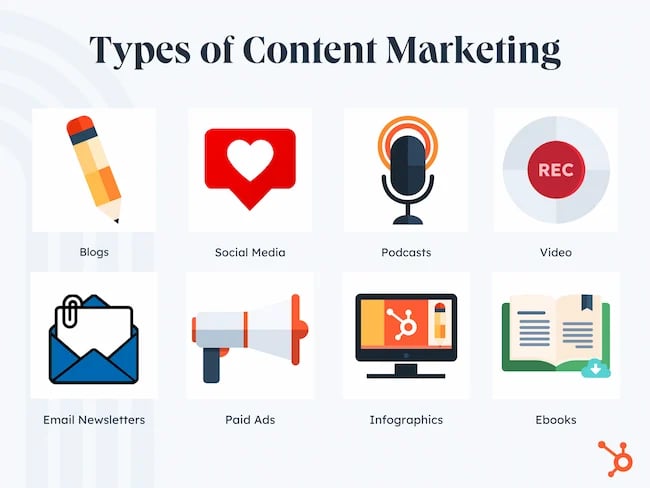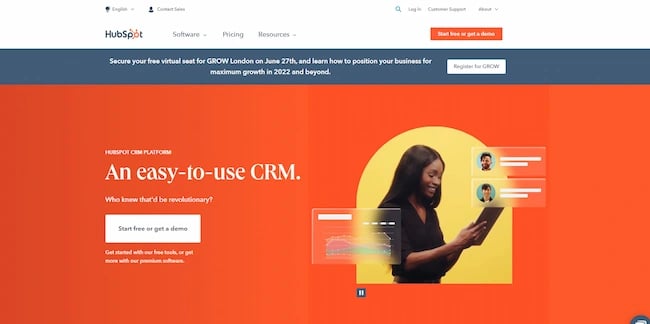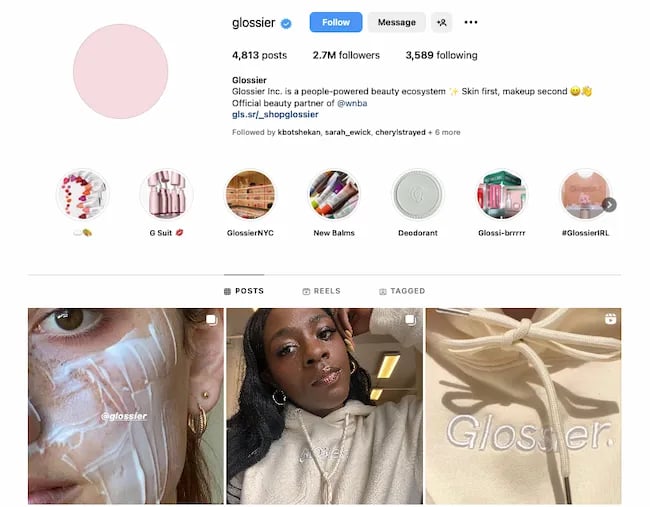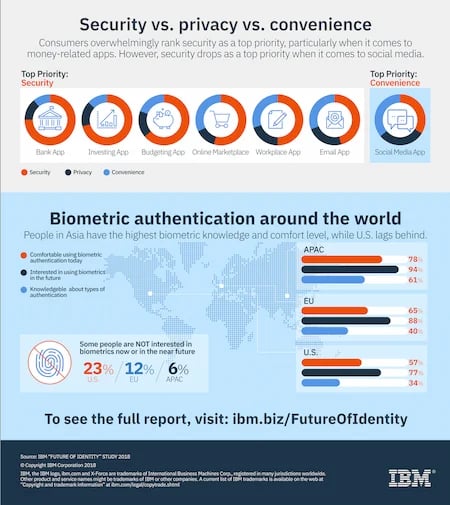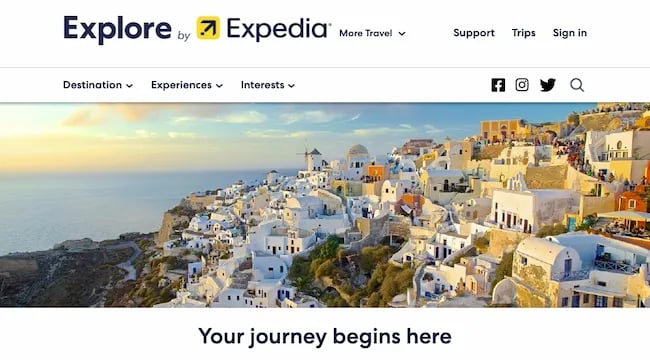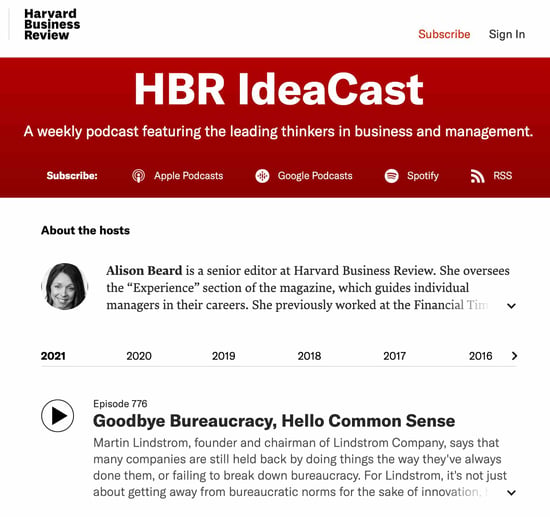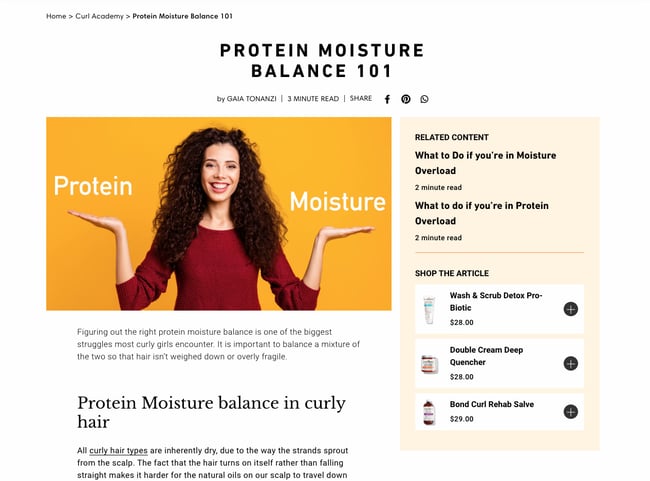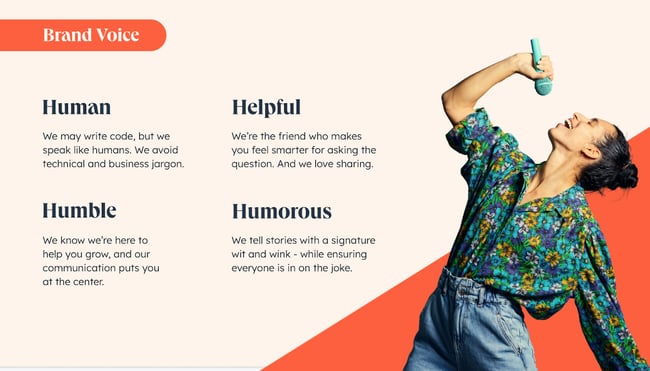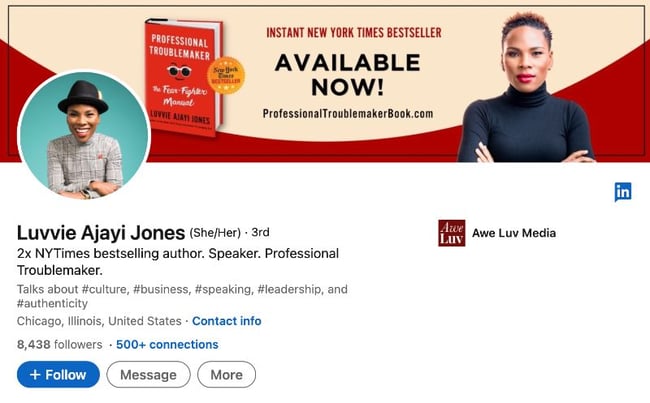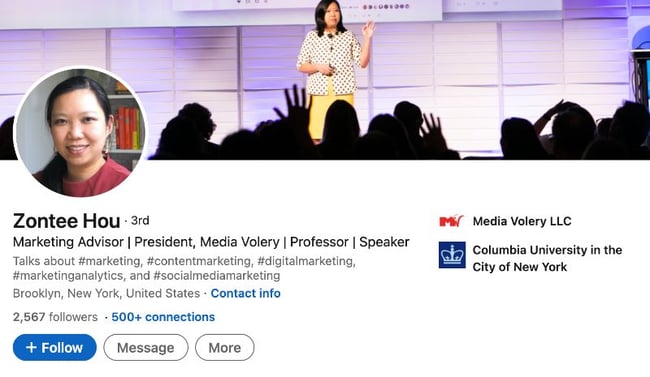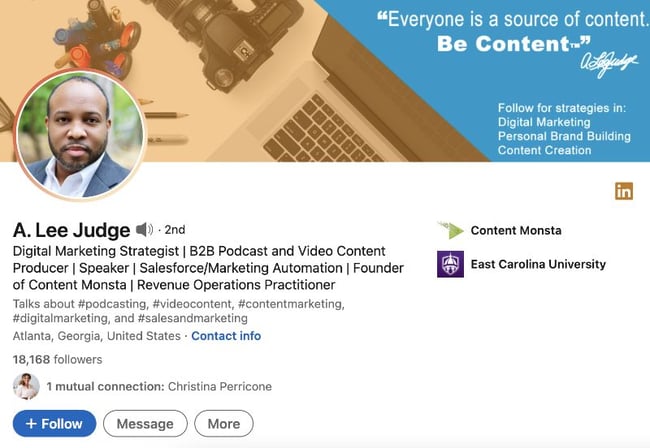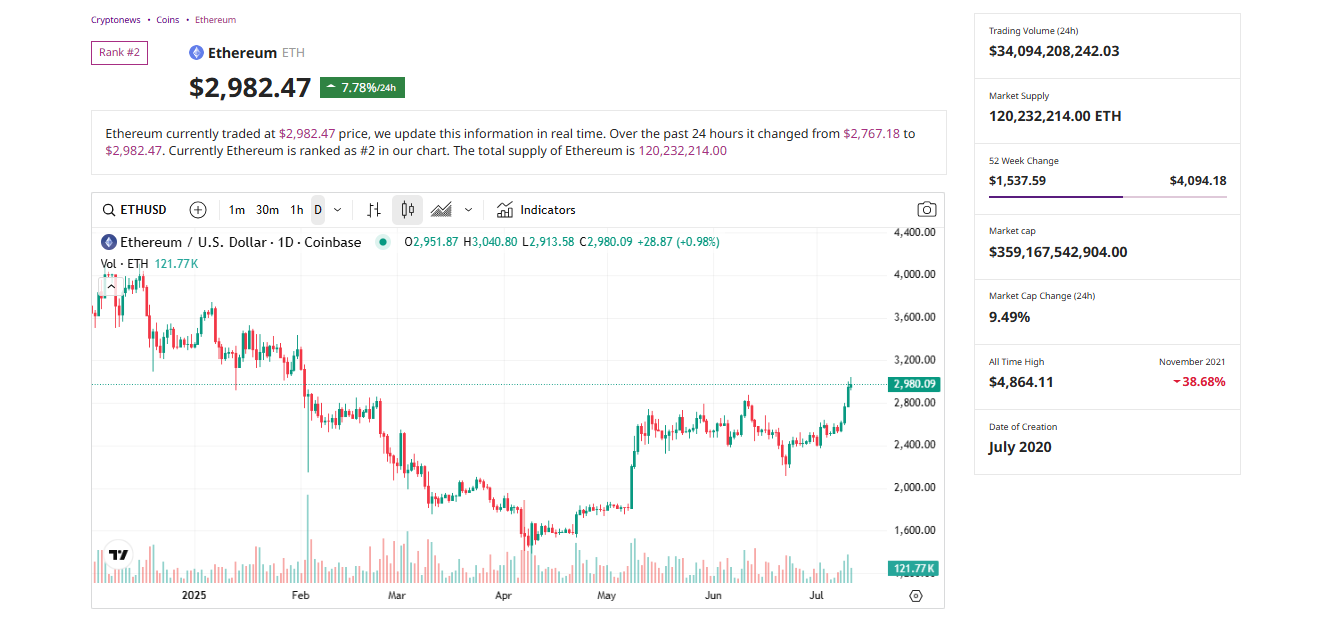Your customers, leads, and audience members want valuable content from your business. And that content needs to reach audience members in a way that feels natural and organic versus being disruptive. Content marketing helps businesses do this, and it describes the process of attracting, engaging with, and delighting your target markets.
By honing in on effective content marketing, you can do just that — and as a result, increase conversions, improve brand awareness, boost revenue, establish yourself as an industry leader, and more.
Whether you’re just starting to devise a strategy or you’re refreshing your existing one, it never hurts to re-assess your process and come up with new ways to create and share the content your audiences want. In this guide, we’ll give you a birds-eye-view of content marketing, types of content marketing, content marketing examples, and how to get a strategy going.
Content Marketing
The definition of content marketing is simple: It’s the process of publishing written and visual material online with the purpose of attracting more leads to your business. These can include blog posts, pages, ebooks, infographics, videos, and more.
However, content marketing isn’t just publishing a thin piece of content and hoping people will find it. It’s about purposefully tailoring your pages, videos, ebooks, and posts to your target audience so that they find you the inbound way rather than the outbound way.
So, what defines content marketing anyway?
Why is content marketing important?
2022 HubSpot research says that 70% of companies use content marketing.
Content marketing is valuable because it:
- Educates your leads and prospects about the products and services you offer. According to 2023 HubSpot research, 29% of marketers use a blog or website for lead attraction and conversion.
- Boosts conversions.
- Builds relationships between your customers and business that result in increased loyalty, and 30% of marketers are creating content that reflects brand values.
- Shows your audience how your products and services solve their challenges
- Creates a sense of community around your brand.
Now let’s look at the various types of content marketing.
Types of Content Marketing
1. Online Content Marketing
2. Social Media Content Marketing
Featured Resource: Social Media Content Calendar
3. Infographic Content Marketing
Featured Resource: 15 Free Infographic Templates
4. Blog Content Marketing
Featured Resource: Start a Successful Blog
5. Podcast Content Marketing
Featured Resource: How to Start a Podcast
6. Video Content Marketing
Featured Resource: The Ultimate Video Marketing Starter Pack
6. Paid Ad Content Marketing
Featured Resource: The Ultimate Google Ads PPC Kit
Next, let’s talk about how content marketing works, and look at some content marketing examples.
How does content marketing work?
Top of the Funnel (TOFU)
Useful content types at the top of the funnel include:
Middle of the Funnel (MOFU)
Great middle-of-funnel content types include:
- Email newsletters
- Product demos
- Landing pages
- White papers
- Case studies
- Longer-form videos
- Blog posts
- Interactive content
- Webinars
Bottom of the Funnel (BOFU)
Bottom-of-funnel content types include:
- Personalized emails
- User-generated content, like customer testimonials
- Case studies
- Pricing pages
- Competitor comparison blog posts
- Video demos
- White papers
- Remarketing campaigns
Check out this post for more on how to align your content with the buyer journey.
Now, let’s look at some content marketing examples.
Content Marketing Examples
1. Example of Instagram Content Marketing
2. Example of Infographic Content Marketing
3. Example of Blog Content Marketing
4. Example of Podcast Content Marketing
5. Example of Video Content Marketing
Image Source
Much of Dollar Shave Club’s video content has gone viral. Their marketing efforts are on-brand, humorous, and entertaining. By establishing a name for itself via online video content, Dollar Shave Club has experienced impressive growth and brand recognition.
6. Example of Paid Ad Content Marketing
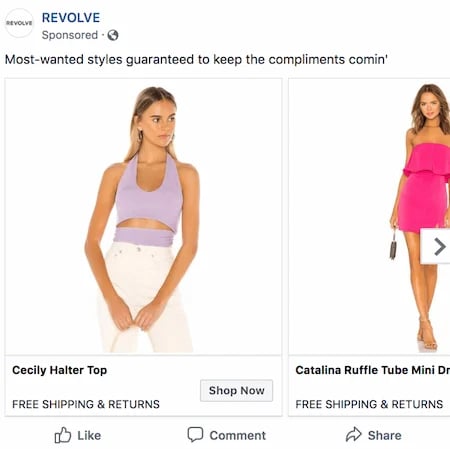
Image Source
Revolve — a clothing and accessories company — uses paid and sponsored ads on social media (like this one on Facebook) to reach their target audience while they browse their news feeds.
The content ads feature some of their products as well as details about their free shipping and return policy to drive target audience members to their site (and, hopefully, convert them into paying customers).
7. Example of Twitter Content Marketing
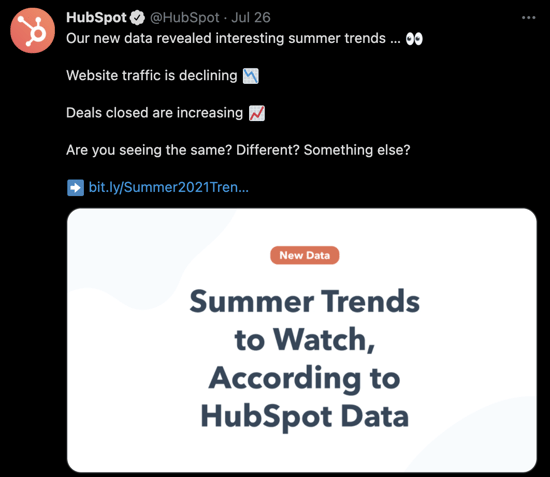
HubSpot uses Twitter to market software as well as create a community among customers, target audience members, and industry leaders and experts.
HubSpot shared product information, relevant tips, industry knowledge, and original research on Twitter. HubSpot also interacts with users and makes sure anyone in need of customer support knows exactly where to go for help.
8. Example of TikTok Content Marketing
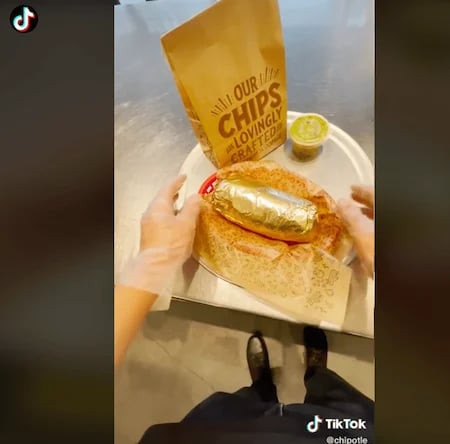
Image Source
Chipotle is an active brand on TikTok — the company uses the platform to reach and engage its customers and target audience members. In addition to reacting to others’ Chipotle-related TikTok content, the brand posts TikToks of their menu items, recipes, people enjoying their food, their restaurants, and more. They have over 2.2 million followers and over 52 million likes.
9. Example of Viral Content Marketing

Image Source
This viral content marketing example was one that came from a TikTok video — Nathan Apodaca’s original TikTok video included him sipping Ocean Spray cranberry juice while skateboarding and listening to “Dreams” by Fleetwood Mac.
As a result of the viral video, TikTok used part of Apodaca’s video in their ads, Ocean Spray used Apodaca in their ads, Ocean Spray saw a bump in sales and brand awareness, Fleetwood Mac’s “Dreams” was number one on iTunes, and there were thousands of videos posted by other TikTok users who bought the cranberry juice and recreated Apodaca’s original video.
Now, let’s cover your content marketing strategy. By implementing a strategy, your content marketing efforts will be impactful and effective in converting leads and reaching your target audience.
Content Marketing Strategy
- Find your target audience.
- Set SMART goals.
- Determine your KPIs.
- Decide on the type of content and content formats.
- Choose your content channels.
- Set a budget.
- Create a content publishing schedule.
- Create and distribute the content.
- Analyze and measure results.
Let’s dive into the steps you’ll want to work through in order to develop an effective content strategy.
1. Find your target audience.
- What do they need from you?
- What challenges are they looking to overcome?
- Why do they need your product or service?
- How can you help them succeed?
- Where do they spend their time?
2. Set SMART goals.
Here are some SMART goal examples and SMART goal templates to help you get started.
3. Determine your KPIs.
| smart goal | related kpi |
| Brand awareness | Site traffic, social media followers, subscription sign-ups, mentions (by customers and partners) |
| Revenue | Daily sales, site traffic |
| Conversions | Conversion rate, shopping cart abandonment rate, associated shipping rate trends, competitive price trends |
| Brand loyalty | Returning customers, promoters, product reviews, referrals |
| Customer engagement | Likes, shares, follows, mentions, backlinks |
| Rapport and trust | Returning customers, promoters, followers, mentions |
| Strategic partners | New partnerships, mentions, backlinks |
4. Decide on the type of content and content formats.
Next, you want to choose the type of content you’ll create and your top content formats.
5. Choose your content channels.
6. Set a budget.
Then, ask yourself the following questions to figure out your budget:
- Do you need to purchase any software or technology to create the content (such as graphic design software like Adobe Photoshop, a subscription to Canva, a camera to take high-quality photos and videos)?
- Do you need to hire any content marketers or designers (such as artists, writers, editors, designers)?
- Do you need to pay for ad space?
- Do you need access to specific tools or resources to enhance or measure your specific type of content?
7. Create a content publishing schedule.
6. Create and distribute the content.
Create and distribute your content so your audience members can consume it — and possibly convert.
9. Analyze and measure results.
Here are some tools to help you with your content marketing strategy analytics and results:
Now, how can you ensure your strategy will be effective? Let’s find out.
Traits of Effective Content Marketing
You can achieve similar results for your company if your content:
1. Provides value beyond your product offerings.
2. Targets readers’ specific buying journey stage.
3. Demonstrates a consistent brand voice and image.
- Your brand visuals look the same across all platforms and devices.
- Your brand tone and voice sound the same across all written communications.
4. Is timely and engaging.
Best Content Marketing Resources
- HubSpot Academy for free education on how to become an effective content marketer.
- HubSpot’s Free Content Creation Resources for access to resources that will propel your content marketing strategy toward success.
- Content Marketing Institute for access to some of the best content marketing online education, print, and events available today.
- Blog articles on content marketing, trends, strategies, and tips by industry experts.
- Podcasts about content marketing, such as This Old Marketing, or business trends, such as HBR IdeaCast, to inspire your content marketing strategy.
- Google Trends, which allows you to search for trends across broad topics like content marketing or for niche topics within content marketing.
- Ebooks and case studies about content marketing and specific content marketing strategies.
- Latest content marketing statistics by a reputable database source like Statista.
- Easy to use visual content and design software, such as Canva.
- Free or paid social media management tools, such as HubSpot, Buffer, or Sprout Social, to help you create and share your social content.
- Free or paid content and project management tools, like Trello or Asana, to plan and organize your content marketing strategy.
- Free or paid marketing software to connect your content marketing team, plan, strategy, and results to your greater marketing plan (and even your CRM).
- Free or paid email marketing software, like HubSpot or Mailchimp, to handle all aspects of your email campaigns and content.
- Your network, on platforms like Twitter or LinkedIn, where you can connect with those in your industry to discuss relevant trends, answer each other’s questions, and provide or ask for feedback.
- HubSpot Academy for free education on how to become an effective content marketer.
- HubSpot’s Free Content Creation Resources for access to resources that will propel your content marketing strategy toward success.
- Content Marketing Institute for access to some of the best content marketing online education, print, and events available today.
- Blog articles on content marketing, trends, strategies, and tips by industry experts (like HubSpot).
- Podcasts about content marketing, such as This Old Marketing, or business trends, such as HBR IdeaCast, to inspire your content marketing strategy.
- Google Trends, which allows you to search for trends across broad topics like content marketing or for niche topics within content marketing.
- Ebooks and case studies about content marketing or content marketing strategies, like this one by Mention.
- Latest content marketing statistics by a reputable database source like Statista.
- Easy to use visual content and design software, such as Canva.
- Free or paid social media management tools, such as HubSpot, Buffer, or Sprout Social, to help you create and share your social content.
- Free or paid content and project management tools, like Trello or Asana, to plan and organize your content marketing strategy.
- Free or paid marketing software to connect your content marketing team, plan, strategy, and results to your greater marketing plan (and even your CRM).
- Free or paid email marketing software, like HubSpot or Mailchimp, to handle all aspects of your email campaigns and content.
- Your network, on platforms like Twitter or LinkedIn, where you can connect with those in your industry to discuss relevant trends, answer each other’s questions, and provide or ask for feedback.
3 Marketers to Follow on LinkedIn
1. Luvvie Ajayi Jones
2. Zontee Hou
3. A. Lee Judge
3 Marketers to Follow on Twitter
4. Ann Handley
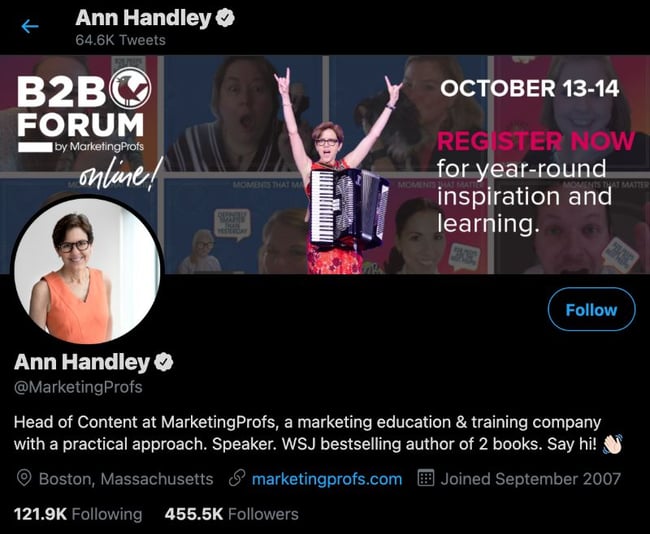
Ann Handley, Head of Content at MarketingProfs, is a bestselling author and speaker. She offers education and training around marketing that businesses can learn from and apply. She offers in-person and virtual training for companies on content marketing, storytelling, lead generation, and branding – topics she also discusses and shares content about on her Twitter page.
5. Neil Patel
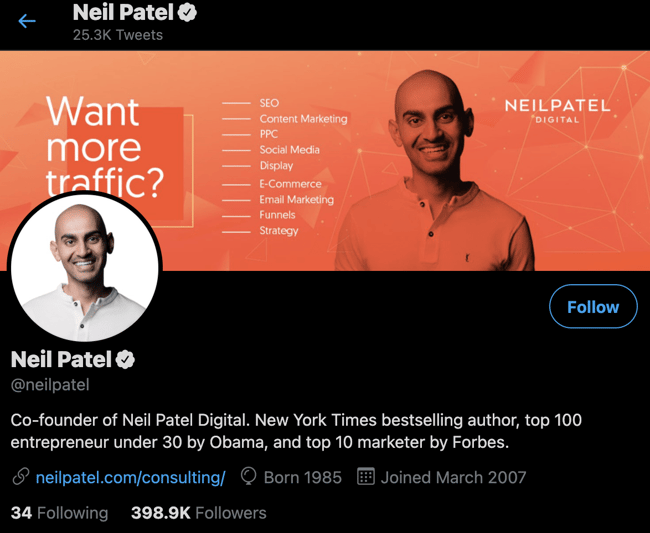
Neil Patel is a bestselling author, marketing expert, speaker, and website and SEO consultant. He’s a thought leader and industry expert in content and digital marketing. His Twitter page includes information about his trainings and services, industry trends, marketing strategy tips and resources, and questions/conversational topics meant to engage followers and other industry experts.
6. Guy Kawasaki
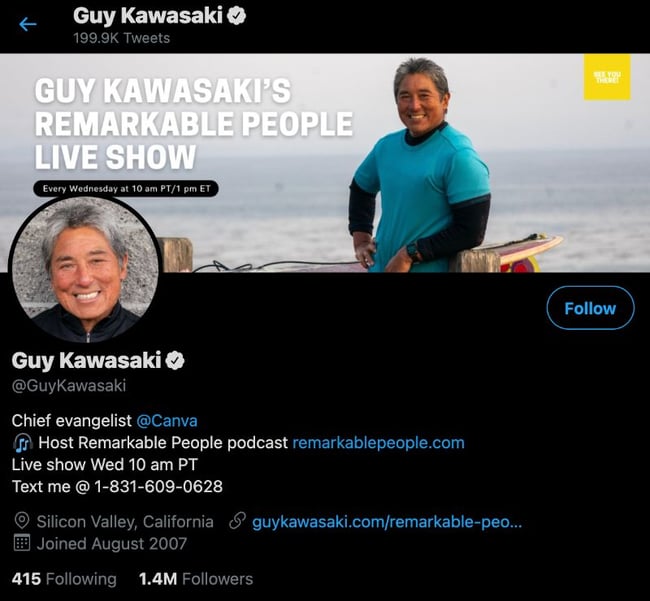
Guy Kawasaki is a marketing strategist, author, entrepreneur, venture capitalist, podcast host, and the chief evangelist of Canva. On his Twitter account, Kawasaki asks followers thought-provoking business questions as well as provides links to, and information about, new podcast episodes, industry trends, marketing strategy tips, and insights based on his experiences.
Engage Your Target Audience With Content Marketing
With effective content marketing, you can reach your target audience and increase conversions. There are several ways to market with content to boost revenue, grow your brand awareness and recognition, and build relationships with your prospects and customers.
And don’t forget to extract more value from every piece of content you create.
To get started, decide which type of content works best for your business and audience and develop a content marketing strategy to begin boosting your bottom line today.
Editor’s note: This post was originally published in August 2019 and has been updated for comprehensiveness.

Credit: Source link


